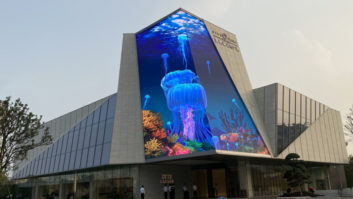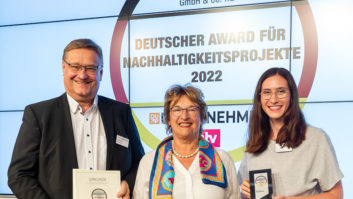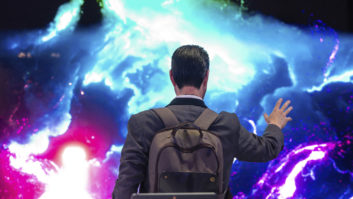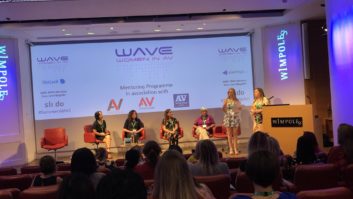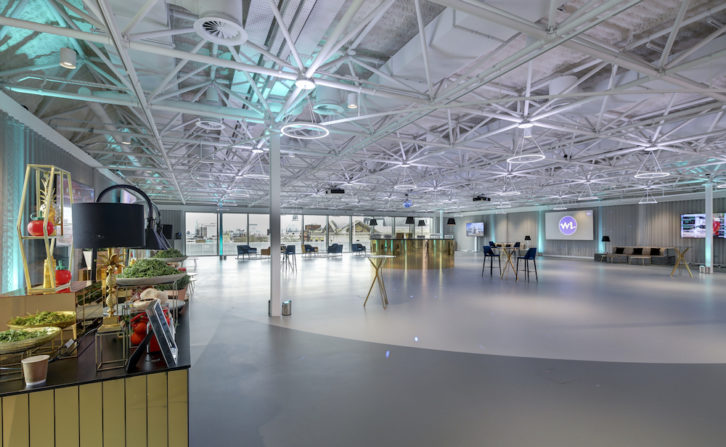
It’s safe to say that we’re considerably more concerned with issues like energy consumption, wastage and maintaining green credentials than we were a decade ago. In today’s sustainability-centric society, end users are consistently looking for energy-efficient products that will last a long time and offer great value over the long term. In a similar vein to the adoption and ever-increasing importance of health and safety workplace practices since the 1970s, companies from all corners of the industry therefore need to embrace sustainability within their thought processes.
Ensuring that sustainable practices are built into an organisation’s operation over the coming years will help to future-proof its business, but are all these things really easier said than done?
Environmental legislation is one major factor to consider as a driver of change, yet it is something that often occurs from the demand rather than the supply of AV equipment, making it heavily dependent on the ethical policies of end users. Companies over a certain size must now comply with standards including the world’s first Ultra Low Emission Zone (ULEZ) in London and Euro 6 emissions, but how much is there a genuine desire among AV manufacturers to effect change?
Managing director at AV solutions integrator White Light, Bryan Raven, sees these measures bringing about positive change, with heightened transparency in the reporting of a company’s carbon footprint. “The challenge with legislation is that it is often slow to catch up with advances in modern technology,” he notes.
“The true lifespan of a product is reflected in its warranty, as that’s what the manufacturer is confident it can cover within the cost.” Joe Benn, Casio Projectors
This can especially be a challenge for companies like US-based loudspeaker manufacturer Meyer Sound, which creates products for a global market where regions and individual countries have varying levels of legislation in environmental policy.
“We find more music events and festivals around the globe following a more environmentally sustainable approach,” says Pablo Espinosa, the company’s vice president and chief loudspeaker designer. “We are recognised as a San Francisco Bay Area green business for our commitment to further reducing our energy consumption.
“We are mindful of green efficiencies in manufacturing: wood waste from loudspeaker cabinets is either converted to pellets for biomass electricity generation or recycled into veneers or gardening mulch. We use – as much as possible – easily recyclable materials in our cabinets like aluminium or wood rather than plastics which in some cases are not recyclable or are expensive to recycle.”
Meanwhile, the guys over at Casio have long been advocates of green AV, and are this year celebrating the 10th anniversary of their entirely lamp-free projector range: “This means no wasted lamps, no mercury and greater energy efficiency,” explains Joe Benn, business development manager at Casio Projectors. “It’s certainly the case that some manufacturer’s spec sheets are based on extremely conservative usage estimates, producing unrealistic specifications in terms of power consumption, or longevity. The true lifespan of a product is reflected in its warranty, as that’s what the manufacturer is confident it can cover within the cost.”
Adam Bennette, technical director at Electronic Theatre Controls (ETC), adds: “While there is currently an absence of clearly applicable standards of measurement for manufacturers, the Single Lighting Regulation – which will come into effect in September 2021 – will impose requirements that will be hard to circumvent. Manufacturers will be obliged to comply and evidence their compliance in a specified and transparent format.”
Shedding some light
With some integrators seeing a “surprising lack of support from manufacturers” with regards to curbing their usage, it is important that they proactively take responsibility themselves. With its vast equipment inventory, White Light is adopting the circular, rather than linear economy model, meaning that wherever possible it will extract and re-use/re-purpose component parts from equipment items to extend their lifecycle.
“If a product genuinely has reached the end of its usage, we have sufficient measures in place to recycle them safely and effectively, helping to significantly reduce wastage and prevent potentially harmful materials from ending up in landfill,” says Raven. “Our fleet is fully Euro 6 compliant and as the in-house production service partner at five major venues, we have an extensive inventory of permanently stocked equipment in Central London. This minimises transport requirements for all events at Central Hall Westminster, Illuminate at the Science Museum, The Mermaid, Claridge’s and The Connaught. Additionally, we can deploy equipment to other close proximity venues we operate in.”
Illuminate at the Science Museum – which has won a hat-trick of awards in its inaugural year – is an interesting example of a new venue space that utilises sustainable AV systems. Designed to be a venue for the future, a core requirement for Illuminate was to ensure its sustainability credentials by using resources and working with suppliers that helped deliver on this goal. As Illuminate’s in-house production service partner, White Light’s strategy for the AV installation included deciding what materials to choose for the proposed style of infrastructure and developing the operating and management processes in accordance with the museum’s own event procedures.
You may also be interested in:
- Green AV: proactive product development
- Green AV: Next steps
- ‘Save the planet right from your conference room’ – Lifesize infographic offers green hints
White Light’s senior project manager, Jason Larcombe comments: “The AV system at Illuminate has been designed to deliver over 70% of events using the installed resources. This reduces the need to bring in additional equipment and therefore minimises transportation and mileage, wear and tear from a high number of bespoke installs and, above all, wastage of materials upon disposal.”
Clients booking Illuminate are encouraged to utilise the many digital branding opportunities available, rather than producing single-use scenic pieces. Meanwhile, all lighting within the space is LED and all projectors are laser, both technologies that are more environmentally friendly than their predecessor solutions.
“Achieving accreditations such as ISO 14001 and B Corp certification is a widely recognised and trusted endorsement of a company’s true green stature.” Bryan Raven, White Light
According to the Science Museum’s Jodie Guilford, “sustainability was embedded throughout Illuminate’s initial design brief, from maximising natural light through the panoramic window and seeking low-energy lighting solutions, to specifying high-quality and durable materials, as well as obtaining our electricity from 100% renewable sources through our supplier. Our organisational approach to energy efficiency has been key to our sector-leading emissions reductions over the past eight years.”
Indeed, forward-thinking manufacturers are always developing new ways to extend the lifespan and boost the power efficiency of their products, which can make a huge difference. Many are engaging in more recycling and trade-in initiatives to ensure that at the end of the lifecycle, equipment is disposed of responsibly and resources are saved along the way.
Transportation alone can be a significant aspect of a green approach, including the transportation of raw materials and sub-assemblies, as Meyer Sound’s Espinosa explains: “We source these from local vendors as much as possible. Our finished loudspeaker products are getting more compact and powerful – this allows for smaller shipping footprints which creates efficiencies both at the initial sale and if the product is used in portable applications by the customer.”
The Bigger Picture
Despite companies going to great lengths to strengthen their sustainability models, it can sometimes be difficult to distinguish between genuine green initiatives and corporate ‘greenwashing’, although this is often much more prevalent in consumer markets. An example of this is carbon-offsetting projects. This gives companies a way to justify emitting large quantities of CO2, as they can pay to offset them when, in reality, the projects might not offset enough to balance out the amount produced.
“Therefore, it becomes hard to prove if these projects are really removing extra carbon from the atmosphere, or are just a marketing stunt,” notes Raven. “Products featuring biodegradable packaging can also be misleading in a green context, as the length of time materials take to biodegrade is the determining factor in how green they really are. Achieving accreditations such as ISO 14001 and B Corp certification is a widely recognised and trusted endorsement of a company’s true green stature.”
The bigger picture of lifecycle analysis should always be the first consideration when specifying equipment, to ensure that items will have as long a life as possible. Researching the supply chain and the carbon footprint that the manufacturing and distribution of specific products generates, prior to purchase, may also help to influence buying decisions with sustainability in mind.
“To maximise equipment utilisation,” Raven continues, “vendors should always consider how and where component parts could be repurposed for an alternative solution, once an item becomes outdated for its intended use. Recycling technology not only prevents further mining and extraction, but is also beneficial financially.”
On the audio side, all of Meyer Sound’s new loudspeaker products are self-powered and utilise far more energy-efficient Class D amplifiers and switch mode power supplies. Users who move their gear around frequently should look for compact products that minimise the truck pack, truck size and even the number of trucks, according to Espinosa: “A sound system that can fit in two trucks rather than three is more environmentally efficient. Meyer Sound prides itself in having the best power-to-size ratio, making for the smallest truck pack in the industry, and eliminating the amp racks makes it even more compact.”
Green Vision
Casio’s Benn sees four key considerations when it comes to looking for green AV. The first is to make sure you’re looking for versatile, flexible solutions which are going to provide you with many different functions: “Why choose several one-trick ponies when one device can do it all?” he says.
When it’s time to compare different products, the next key consideration should be power consumption, especially if it’s a big roll out or if the equipment is going to be used for long periods of time. “After that, it’s longevity,” he advises. “Lots of manufacturers design products with “planned obsolescence”, which means it’s designed to break after a certain period of time to try and stimulate more business. To avoid this, choose a manufacturer which is known for long lifecycles and reliability.
“Finally, consider supply chains and sustainable sourcing of materials. It’s well-known that lots of electronics contain irresponsibly sourced or even dangerous metals, such as mercury. This should be avoided as much as possible.”
This being said, how much of an issue can we really expect this to be going forward, and what steps are being taken to increase the sustainability of the AV industry? White Light is already taking significant strides in the development of technology to reduce the carbon footprint of travel, in markets including broadcast, education and corporate communications. An example of this is SmartStage, an immersive video environment which replaces the traditional green screen element of a virtual studio.
Sustainable green practices are a win for everyone involved, representing smart business in terms of less waste, reduced carbon footprints and reduced business costs. Many end users are looking to work with manufacturers who have robust sustainability practices, while the larger entertainment industry is also finding ethical and business value in being more sustainable.
In the world of live events, many of Meyer Sound’s partners embrace green practices and have made sustainability a key part of their vision, especially with the likes of Denmark’s Roskilde Festival where sustainability is at the forefront. In 2019, the festival introduced more sustainable reusable glasses rather than bio-based disposable plastic cups which were used previously.
“As everyone becomes more engaged with environmental issues, all industries will have to respond,” advises Benn. “Most manufacturers have cleaned up their act to some degree, but I think further steps will have to be taken. However AV can be a part of this, the most obvious area is in the rapid advancements being made in video conferencing technology, mitigating the need for travel, and thereby lowering emissions.”
Across the channel, greater considerations are being made in everything from power efficiency to supply chain responsibility and manufacturers that don’t take those steps may be at risk of falling behind.
